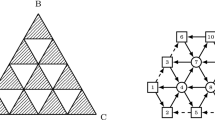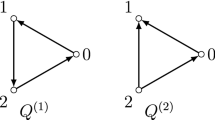Abstract
A cluster variety of Fock and Goncharov is a scheme constructed by gluing split algebraic tori, called seed tori, via birational gluing maps called mutations. In quantum theory, the ring of functions on seed tori are deformed to non-commutative rings, represented as operators on Hilbert spaces. Mutations are quantized to unitary maps between the Hilbert spaces intertwining the representations. These unitary intertwiners are described using the quantum dilogarithm function \(\Phi ^\hbar \). Algebraic relations among classical mutations are satisfied by the intertwiners up to complex constants. The present paper shows that these constants are 1. So the mapping class group representations resulting from the Chekhov–Fock–Goncharov quantum Teichmüller theory are genuine, not projective. During the course, the hexagon and the octagon operator identities for \(\Phi ^\hbar \) are derived.
Similar content being viewed by others
Notes
In the case of cluster variety coming from a punctured surface, this group coincides with the mapping class group of the surface.
References
Barnes, E.W.: Theory of the double gamma function. Philos. Trans. R. Soc. A 196, 265–388 (1901)
Berenstein, A., Zelevinsky, A.: Quantum cluster algebras. Adv. Math. 195(2), 405–455 (2005)
Derksen, H., Weyman, J., Zelevinsky, A.: Quivers with potentials and their representations II: applications to cluster algebras. J. Am. Math. Soc. 23(3), 749–790 (2010)
Faddeev, L.D.: Discrete Heisenberg–Weyl group and modular group. Lett. Math. Phys. 34, 249–254 (1995)
Faddeev, L.D., Kashaev, R.M.: Quantum dilogarithm. Mod. Phys. Lett. A 9, 427–434 (1994)
Faddeev, L.D., Kashaev, R.M., Volkov, A.Y.: Strongly coupled quantum discrete Liouville theory, I: algebraic approach and duality. Commun. Math. Phys. 219, 199–219 (2001)
Fock, V.V., Goncharov, A.B.: Cluster Ensembles, Quantization and the Dilogarithm II: The Intertwiner in Manin’s Festschrift. Birkhäuser, Boston (2007)
Fock, V.V., Goncharov, A.B.: The quantum dilogarithm and representations of the quantum cluster varieties. Invent. Math. 175, 223–286 (2009)
Fock, V.V., Goncharov, A.B.: Cluster ensembles, quantization and the dilogarithm. Ann. Sci. Éc. Norm. Supér. (4) 42(6), 865–930 (2009)
Fomin, S., Zelevinsky, A.: Cluster algebras I: foundations. J. Am. Math. Soc. 15(2), 497–529 (2002)
Fomin, S., Zelevinsky, A.: Cluster algebras IV: coefficients. Compos. Math. 143, 112–164 (2007)
Frenkel, I.B., Kim, H.: Quantum Teichmüller space from the quantum plane. Duke Math. J. 161(2), 305–366 (2012)
Funar, L., Sergiescu, V.: Central extensions of the Ptolemy–Thompson group and quantized Teichmüller theory. J. Topol. 3, 29–62 (2010)
Goncharov, A.B.: Pentagon relation for the quantum dilogarithm and quantized \(\cal{M}^{\rm cyc}_{0,5}\). In: Geometry and Dynamics of Groups and Spaces, Progress in Mathematics, vol. 265. Birkhäuser, Basel, pp. 415–428 (2008)
Gross, M., Hacking, P., Keel, S., Kontsevich, M.: Canonical bases for cluster algebras. J. Am. Math. Soc. 31(2), 497–608 (2018). arXiv:1411.1394
Hall, B.C.: Quantum Theory for Mathematicians. GTM, vol. 267. Springer, New York (2013)
Ip, I.C.: Positive representations of split real quantum groups: the universal R operator. Int. Math. Res. Not. IMRN 1, 240–287 (2015). arXiv:1212.5149
Kashaev, R.M., Nakanishi, T.: Classical and quantum dilogarithm identities. SIGMA Symmetry Integrability Geom. Methods Appl. 7, Paper 102, 29 pages (2011). arXiv:1104.4630
Keller.: On cluster theory and quantum dilogarithm identities. In: Representations of Algebras and Related Topics, EMS Ser. Congr. Rep., Eur. Math. Soc., Zürich, pp. 85—116 (2011). arXiv:1102.4148
Kim, H.: The dilogarithmic central extension of the Ptolemy–Thompson group via the Kashaev quantization. Adv. Math. 293, 529–588 (2016). arXiv:1211.4300
Kim, H.: Phase constants in the Fock–Goncharov quantization of cluster varieties: long version. arXiv:1602.00361v2
Kim, H.: Irreducible self-adjoint representation of quantum Teichmüller space and phase constants. arXiv:2001.06802
Kim, H., Scarinci, C.: Quantum moduli spaces of \((2+1)\)-gravity (in preparation)
Kim, H., Yamazaki, M.: Comments on exchange graphs in cluster algebras. Exp. Math. 29(1), 79–100 (2020). arXiv:1612.00145
Reed, M., Simon, B.: Methods of Modern Mathematical Physics I: Functional Analysis. Revised and Enlarged Edition. Academic Press, San Diego (1980)
Schmüdgen, K.: Unbounded Self-Adjoint Operators on Hilbert Space, GTM, vol. 265. Springer, Dordrecht (2012)
von Neumann, J.: Die Eindeutigkeit der Schrödingerschen Operatoren. Math. Ann. 104, 570–578 (1931)
Woronowicz, S.L.: Quantum exponential function. Rev. Math. Phys. 12(6), 873–920 (2000)
Xu, B.: Central extension of mapping class group via Chekhov–Fock quantization. J. Geom. Phys. 110, 9–24 (2016)
Acknowledgements
I would like to thank Myungho Kim, Dylan Allegretti, Ivan Chi-ho Ip, Carlos Scarinci, Seung-Jo Jung, Woocheol Choi, Louis Funar, Vladimir V. Fock, and Alexander B. Goncharov for helpful discussions. This research was supported by Basic Science Research Program through the National Research Foundation of Korea (NRF) funded by the Ministry of Education (Grant Number 2017R1D1A1B03030230).
Author information
Authors and Affiliations
Corresponding author
Ethics declarations
Conflict of interest
The authors declare that they have no conflict of interests.
Additional information
Publisher's Note
Springer Nature remains neutral with regard to jurisdictional claims in published maps and institutional affiliations.
Rights and permissions
About this article
Cite this article
Kim, H.K. Phase constants in the Fock–Goncharov quantum cluster varieties. Anal.Math.Phys. 11, 2 (2021). https://doi.org/10.1007/s13324-020-00439-3
Received:
Revised:
Accepted:
Published:
DOI: https://doi.org/10.1007/s13324-020-00439-3




